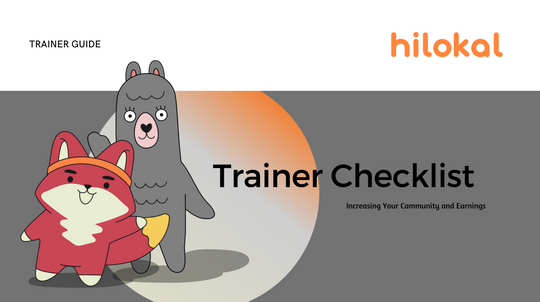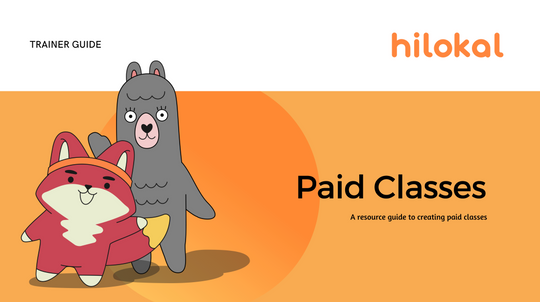Introduction
Welcome!
So you've decided to become an English trainer here at Hilokal or you've been here for a while but need some guidance to improve your English lessons? Well, you've come to the right place!
In this guide we will take a look at a few areas, that when executed well, will lead to running and managing a successful lesson.
I'm sure that a lot of what is covered may not be new to you or you may be implementing these practices in your classes already. So take what you need from these principles and make then your own.
There is no one way to teach. Each trainer is different and that is a good thing! It means that many students can benefit from a wide pool of unique teaching.
So here we go .... you ready?
Preparation
Preparation is the key to success! Plan and schedule lessons in advance. Decide what you want to teach, how you want your classes to run. You don’t have to do it all, there are plenty of other trainers out there who will cover things that you are just simply not interested in doing.
Do you want to just have casual conversations with people allowing them to freely develop their speaking and listening skills? Then just do that. Or maybe you like the structured teaching environment where you offer planned lessons focused on grammar. Then do that! Or maybe you want the best of both worlds? Whatever you decide make sure that it is fun and interesting for you. Nobody wants a teacher who sounds bored or disinterested!
Students respond well to consistency, so, if possible, schedule your tables at the same time and on the same days. This way students will become familiar with your schedule.
If you decide on more casual “conversation” tables, prepare a few questions or topics beforehand. This will help keep the flow of conversation going and when there is that awkward silence (yeah, we all know about that!), you can pick it up again and generate conversation, as you have prepared material ahead of time. For these types of classes, you would take on a facilitator role and guide the conversation so that all students are included.
It goes without saying that if you are running English teaching tables, then know your stuff! If you are teaching about verb tenses, for example, make sure you brush up on the rules and know how to explain it when questions arise from students (and they will!). Make your slides interesting, colourful and attention grabbing. Look, nobody expects you to be an English professor, but running quality classes will ensure that students will want to learn from you again.
Class Structure
More formal teaching classes should have some sort of a class structure so that students know you are in the driving seat, and they can happily follow along. Depending on the type of class it is, this structure may be very “loose” or “solid”. This sets the pace for the entire lesson. Make it easy for students to follow the class without any confusion.
A basic English teaching class could look like this, with a rough timeframe:
- Welcome and a little chit-chat as you wait for people to join, as well as adding slides to the whiteboard/chat-box. (5 min)
- Introduction – explain what you are doing in the class today. (2 min)
- Definition of the topic e.g. definition of a verb. (5 min)
- Teaching the topic e.g. you may be teaching different verb tenses. After each explanation make sure to include a few examples before moving onto the next one. Ask students if they understand or have any questions after each section. Give space for feedback and clarity if there is any confusion. (18 min)
- Now turn it over to them! Offer many examples that they can work through with your help. Let them take turns speaking and trying the work. Offer gentle correction and loads of encouragement! (25 min)
- You’ve come to the end of the lesson with 5 minutes to go, take any last questions, have a laugh or two and wrap it up. Encourage them to save the notebook so they can look over them at another time. (5 min)
- Encourage the class on how well they did and show a genuine interest in seeing them again in your next class.
- Before you say your final goodbyes, ask students to check your schedule on your profile. This will allow them to be notified and join your next class!
Class Management
Master how to read the room!
It’s all very well having great material to share with your students, but if you lack the skills in managing people and class flow, then you may have a very hard time. If this type of management doesn’t come naturally to you, don’t worry! This is a skill, that with a little practice, you can learn and improve on. You may be more of an introvert, a little shy, especially in your first few classes, or you may not know how to balance taking on a leadership role with giving students the floor.
This can be a tricky thing to balance, especially if you have some rather strong personalities sitting at your table. Often these people may “hog” the airtime leaving other speakers in the dust. As the trainer, it is your responsibility to manage such situations and restore the balance, so each person has an equal chance for class involvement.
Here are a few ways this can be achieved:
1. Take control of the table as soon as you press the START button! This is your table, you make the rules, you decide how it is run.
2. Be confident as you welcome and interact with students.
3. As you are introducing the lesson to the class, explain how things will run, explain how speakers will have turns and you will call on them when it is their time. If someone has a question, they could use the ‘wave’ emoji to signal you and when you are able you will get to them.
4. If all chairs are full, make sure to “rotate” people giving the listeners a chance to speak once the others have had a turn. Ask speakers to come down from the table and give up their chair for others. Most students are very generous and understand this concept. Encourage student involvement by giving lots of examples in your lesson.
5. A good rule of thumb is to keep a good teacher/student “vibe”. If you are overly casual or talk too much about yourself, then some people may very well take advantage of that. Be professional but friendly.
6. Different personalities require different approaches. How do you encourage a shy person vs how do you gently keep a “talker” on your side? For someone who is shy or not so confident in their speaking abilities a lot of gentle encouragement is good. They will respond better to you if you show a genuine interest in them and in helping them. Suggest that you do examples together and remind people that getting something wrong is not a failure but a steppingstone for improvement.
On the opposite end of the scale, if you are dealing with a person who is a bit “excitable” and tends to take-over, like answering questions when it’s someone else’s turn, you could simply remind them that you will get to them when it’s their turn. You could say something like, “Bob, you’re on a roll tonight! But it’s Petunia’s turn and I would love her to practice too. I’m getting to you soon Bob, make sure you’re ready!”
Keep it positive, simple and low-key.
7. Now of course every now and then we encounter the bad eggs...you know the ones that leave a stench...yeah, those rude people who are just inconsiderate and disruptive. Here’s what you do... after a subtle warning, click on their profile, hit the “kick” button and poof! They will be gone.... bye Felicia! All jokes aside, nobody wants to waste time dealing with this type of person and your students will probably give you a round of applause as you swiftly boot them out! Then move on... stay calm, don’t become flustered or angry, just take control.
8. Set up scenarios beforehand of things you have encountered or things that could be negative in class and produce some solutions, this way when it happens in class you are prepared. Practice on your dog! A little role-playing never hurt anyone.
9. It’s also good to note that periodically during the class you can welcome new listeners. This may not always be possible especially if you have many people you are managing, but it’s a very nice gesture for the listener. Let’s face it, everybody wants to be acknowledged.
10. A note on technical app issues: we love Hilokal but, as with any app, we often encounter those pesky “bugs” who like to steal the limelight! Well, it’s going to happen (sorry love!). There is going to be a time where no one can hear you, or you cannot post on the whiteboard, or the app is lagging, or no one voted you the best singer of all time (that’s a technical issue right!?). At that moment it’s out of your hands, it’s out of your control. What IS in your control is how you handle it.
You could curse... #F*V%$H%#@^*&#$, but yeah, that would be a little unprofessional. Not recommended haha! Best to try and rectify the situation by maybe leaving the app, refreshing, and coming back or in the worst-case scenario re-starting the table. Yes, it’s annoying.... I know. If it doesn’t come right, ask yourself if there’s a way you can teach around the problem?
Make sure to report it to Hilokal.... they LOVE catching bugs!
Okay, here’s the bottom line... you learn from experience! You just have to get in there and do it. When you encounter a difficult situation apply what you have learnt and then after class re-visit the scenario and see if there was a better way for you to have handled it. It may not necessarily have been a rude person for example. Maybe something else fell short, like remembering to give everyone a chance to speak. Always reflect after your lesson to see what improvements you can make.
Building a Following
We all envision having lots of regular students, a large following and to be hailed “trainer of the year” Haha! Well, it doesn’t happen overnight, it may even take a few months. One thing is for sure, people will return to trainers who they can relate to, where they feel that their contribution matters and whereby, they are seeing improvement in their English.
Here are some ways to encourage people to click that follow button and keep returning to your tables:
- Take a genuine interest in each person.
- Remember small details about regular students.
- If you don’t know how to pronounce their name, ask them (people appreciate you saying their name correctly).
- Be excited! Show enthusiasm in your class.
- A little humour goes a long way. Have a few chuckles in class.
- Point students to your scheduled classes at the end of every table, encouraging them to “hit that notification bell”.
- Be helpful and friendly.
- Be encouraging.
- Check and answer messages regularly (ignore random spam!)
A Final Note
Make sure you enjoy what you do, if you don’t change it up, experiment, try different things until you find what “sparks joy”.
Ask for help, just because you’re a trainer doesn’t mean you always know what to do. If you are starting out, reach out to trainers who have been going for a while and ask for advice or help. I’m sure if you add a “pretty please” they will be more than willing to impart a few pearls of wisdom.
Lastly, do what works for you. The above are suggestions, a place to start. To infinity and beyond!









